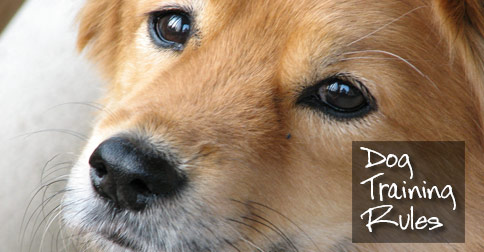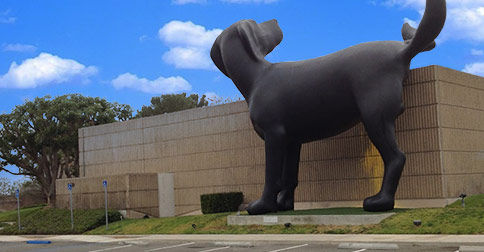 Basic dog training rules are critical for you to follow to get the most out your training program. Review the rules below. Repeat them aloud and work to understand each of them. These could make or break your training efforts.
Basic dog training rules are critical for you to follow to get the most out your training program. Review the rules below. Repeat them aloud and work to understand each of them. These could make or break your training efforts.
The only time you are teaching your dog is when she is making a choice. You must use the correct tool at the time of the choice to get the results you want. Praise is the only way to truly teach your dog what you want in a way she is willing to do that thing.
–Bennie Copeland
RULE #1) The only time you are truly teaching your dog is when she is making a choice and you praise for that choice.
This means: First you have to know that your dog is making and choice and second, you have to know what you want your dog to do.
RULE #2) Three Correction Rule:
Part 1: Frustration and anger change expectation. When working with your dog on a command she knows, once you give three corrections for a particular command it is time to move on to something else.
Either release your dog from that command (by saying “All done”) or physically put your dog into the desired position.
Part 2: A correction is when your dog to stops doing what she is doing and pays attention. This means you need to correct to a level that she pays attention.
If you correct out of anger, then you probably are correcting too hard and chances are you will not praise once she responds to you.
If you correct too softly, then you are not making your dog stop doing what she is doing and pay attention. This would not be considered a correction.
Part 3: When you are using distraction as a part of the training, if you have had to correct your dog back to the command three times, then that level of distraction is too high.
Part 4: If you find you are correcting more than three times for a command your dog knows, then you must do something to reinforce your dog’s willingness to do that command for you. You have to look at the following:
Are you over-motivating for that command?
Are you under-correcting for that command?
Are you using praise at the appropriate moment?
Are you using praise enough in other aspects of training?
RULE #3) Praise always has to be at a much higher level than correction.
RULE #4) Always use motivation before correction when there is a choice.
When you are using motivation as a tool, your dog is more likely to remember the command and more like to want to do that command.
RULE #5) Correcting for something you never want vs. correcting for something you want her to stop doing when told:
- Unwanted behavior: If you are correcting for a behavior you never want your dog to do, make the correction a verbal “NO.” Once the correction has been given, you ignore your dog for at least one-minute. Never praise your dog after a “no” correction.
- A behavior to stop when told: If your dog is doing something you are okay with and you just want them to stop on command, the correction is a word or phrase (such as “Hush”). If they then stop the behavior (go quiet), you immediately praise them. If they don’t stop the behavior, you then correct with a “no” and follow the first part of this rule.
RULE #6) The Rule of “No”: Whenever you pull on the leash you must say “No” and whenever you say “No,” you must pull the leash.
RULE #7) Always end a command on a positive note, no matter how you feel or what happened during that command.
RULE #8) 10:1 Ratio: For every one time you correct your dog for anything you have to praise her ten times for making the decision you want in that situation.
Lifetime 10:1: You know you have reached the level of praising your dog ten times more than you ever have corrected her for doing a behavior in her lifetime when she chooses to do that behavior even when she is on her own.
RULE #9) Your dog must do any one thing ten times in a row before moving up to the next level of training.
RULE #10) Stay is incorporated in all commands and does not need to be said. Your dog is released when you say “All Done”.
RULE #11) ALL DONE means your dog is finished with the last command you gave. Use this command throughout your workout. Usually the novice trainer will only use this command at the end of the entire workout or only while praising for completing a command. This creates that your dog thinks she is done with the workout entirely and/or that praise is also a release.
RULE #12) Enjoy your dog and enjoy your workout so your dog can enjoy you!
RULE #13) Post training routines:
- Once you have completed training, you should still continue to work on the commands for the next month or so at least two to three times a week. Each session should include three to five of each command you have learned up to this point.
- You should continue to work on the place command (two to three times a week) until you can build-up that your dog will hold the command for 30 minutes.
Rule #14) There are three stages to training off-leash. (This process takes over a year)
- On-leash (2-3 months)
- On-leash without touching the leash (add another 4-5 months)
- Totally off-leash (add another 6-7 months)
When starting the off-leash process there are 3 rules to follow for consistency in training.
The following is just basic premise of each rule with a brief description.
Without having gone through my training program, these rules may not have the same impact or mean much to you. They are here as a follow-up for past clients as well as a peek inside my basic theories for training.
These rules are only to be used when your dog is off-leash and these rules are only for you, the owner, they have nothing to do with your dog.
The 3 Rules for Consistency
- Whenever you give a command, no matter what happens, you must always end that command in a positive way.
- Once you have given a command, you cannot touch your dog or the leash, and you must do everything in your power to get your dog to do the command.
- If the command it unsuccessful, before you ever do that command again you have to pick up the leash and do that command 10 times before trying it off-leash again.
 You can listen to Bennie directly by clicking the play button in the player , or read the notes below.
You can listen to Bennie directly by clicking the play button in the player , or read the notes below.
 Every Puppy Can Be Potty Trained
Every Puppy Can Be Potty Trained